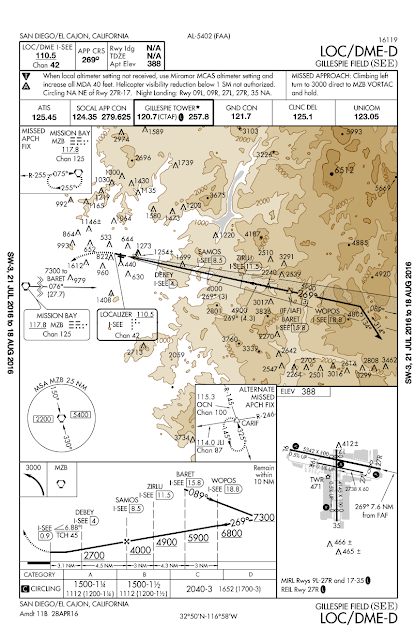Piper Cherokee (PA-28-161/A)
Hobbs:
2.0 hours
Landings:
2
Flight profile:
Instrument flight. File and fly VOR circle to land approach Brown Field (SDM) full stop (Depart runway 28L Montgomery Field MYF). File and fly LOC/DME approach Gillespie Field (SEE) missed approach, practice ILS approach land 28R MYF.
 |
| LOC/DME Approach, Gillespie Field |
Today I flew my first 2 non-precision approaches in many years. For the MYF to SDM leg, a couple of things to note:
- I made the approach without having obtained the ATIS at SDM. I'm pretty sure the controller never asked us to get the ATIS and reply back when we had it, and when we realized we didn't have it, it was a bit late in the game to go calling for it, as we were about to get handed off to the tower and just about to the missed approach point (thus the workload was getting heavy). Lesson learned: don't expect ATC to remind you about getting ATIS, and be prepared to initiate conversation with ATC if it is getting to a point in the vectoring where it might be too late (or workload too high) to switch over and obtain it.
- I was prompted by my instructor when we were already far along in the approach to ask ATC if we should contact tower (they replied in the affirmative). My instructor made a comment that basically he felt that ATC had forgotten us. Here, the lesson again is to know what to expect and when to expect it during an approach, and when the expected does not happen, get on the radio and ask.
We landed full stop, taxied to transient parking, got set up there with a new clearance to KSEE. We went full stop to give me a bit of a breather after having flown the first non-precision approach before going on to the second.
Nothing particularly noteworthy occurred during the SDM to SEE approach portion of the flight. I had studied the approach plates ahead of time, but given the high approach angle and the fact I almost never fly into SEE, I felt a little concerned about the approach. But my instructor and I, prior to the flight, went over the details of the approach. I had a plan coming to the airport for how to manage any non-precision approach -- scan the DME and approach plate while being vectored ahead of intercepting the localizer, to get a feel for about where in the approach we were going to ultimately join, and the corresponding altitude. During the approach, the process would be to look ahead the next step down fix (DME) and following altitude, and of course, the missed approach point and decision height/altitude. My instructor pointed out that we would be likely vectored on all approaches to within 3NM of the Final Approach Fix (FAF), which helped to narrow to the step down fix just before the FAF, and just after.
Nothing particularly noteworthy occurred during the SDM to SEE approach portion of the flight. I had studied the approach plates ahead of time, but given the high approach angle and the fact I almost never fly into SEE, I felt a little concerned about the approach. But my instructor and I, prior to the flight, went over the details of the approach. I had a plan coming to the airport for how to manage any non-precision approach -- scan the DME and approach plate while being vectored ahead of intercepting the localizer, to get a feel for about where in the approach we were going to ultimately join, and the corresponding altitude. During the approach, the process would be to look ahead the next step down fix (DME) and following altitude, and of course, the missed approach point and decision height/altitude. My instructor pointed out that we would be likely vectored on all approaches to within 3NM of the Final Approach Fix (FAF), which helped to narrow to the step down fix just before the FAF, and just after.
Talking through all of this on the ground actually made the approach quite doable and enjoyable. Trying to figure out a strategy and learn the approach in the airplane on the spot without a plan and prior study of the plates would have resulted in some moments of stress and mistakes, I believe. Thinking ahead of the airplane is not all that unusual, in fact, I believe it is a core competency of a safe and effective pilot. Even as a VFR pilot, you don't just get in the plane or go (at least I don't). I always have a plan of what I am going to do before the prop starts turning.
The other interesting thing I learned about today was the practice approach. We were given a practice ILS approach into MYF, and effectively, what it meant was that I was still on an instrument clearance (ultimately, ATC contacted me and asked me to switch to tower), but they were not going to provide altitude and heading assignments, I was on my own. When they gave me the instruction that I was cleared for the practice approach, it was done after being given a heading that would lead me to intercept the ILS, and an altitude of 4000. I continued on to 4000, which put me above the glideslope on intercept (but in IFR flight, I suppose above is always better than below!). Getting down to the glideslope and the rest of the approach was uneventful.
Some tips from my instructor. Stop using "with you", "looking", and "this is" in my communications. Also, need to work on saying tail number at start of communications, not at the end (with ATC, not necessarily tower).
All in all, a great flight.
Next week, we take to V23 and do various holding pattern entries.
No comments:
Post a Comment